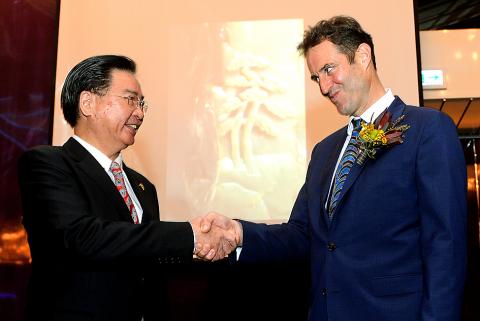National Palace Museum (NPM) masterpieces, including the famed “meat-shaped stone” are to be exhibited in Sydney for the first time starting next month, Australian Office Taipei Representative Gary Cowan announced yesterday.
Cowan made the announcement at a ceremony in Taipei celebrating Australia’s national day, which falls on Saturday, as he recounted achievements in bilateral relations since he took up the post in January last year.
“From February, the Art Gallery of New South Wales in Sydney will host ‘Heaven and Earth in Chinese Art,’ a collection of some of the most treasured pieces in the NPM’s collection,” Cowan said.

Photo: Lin Cheng-kung, Taipei Times
In return, the National Museum of Australia is to send some of Australia’s national treasures, including a collection of bark painting masterpieces by Aboriginal artists, to the NPM later this year, he said.
The Art Gallery of New South Wales’ Web site says that the exhibition, which is to open on Feb. 2 and run through May 5, features 87 items ranging from paintings, calligraphy, illustrated books and bronzes, to ceramics and jade, including the banded jasper in the shape of a piece of braised pork belly from the Qing Dynasty.
“As we share our treasures, we create trust, we create cooperation and we create a better future for ourselves,” Cowan said.
Minister of Foreign Affairs Joseph Wu (吳釗燮) said that the exchange of exhibitions is an important event that could facilitate mutual understanding and friendship between Taiwan and Australia, which is home to 18,000 Taiwanese students and 16,000 Taiwanese participating in Australia’s working holiday program.
Since President Tsai Ing-wen (蔡英文) took office in 2016, bilateral ties have grown stronger, as evidenced by a nearly 18 percent growth in trade and a 24-fold increase in Taiwanese investment in Australia in 2017, Wu said.
The two nations have also seen closer cooperation in the areas of education, science, agriculture and tourism, Wu added.

The Central Weather Administration (CWA) yesterday said it expected to issue a sea warning for Typhoon Fung-Wong tomorrow, which it said would possibly make landfall near central Taiwan. As of 2am yesterday, Fung-Wong was about 1,760km southeast of Oluanpi (鵝鑾鼻), Taiwan’s southernmost point, moving west-northwest at 26kph. It is forecast to reach Luzon in the northern Philippines by tomorrow, the CWA said. After entering the South China Sea, Typhoon Fung-Wong is likely to turn northward toward Taiwan, CWA forecaster Chang Chun-yao (張峻堯) said, adding that it would likely make landfall near central Taiwan. The CWA expects to issue a land

Taiwan’s exports soared to an all-time high of US$61.8 billion last month, surging 49.7 percent from a year earlier, as the global frenzy for artificial intelligence (AI) applications and new consumer electronics powered shipments of high-tech goods, the Ministry of Finance said yesterday. It was the first time exports had exceeded the US$60 billion mark, fueled by the global boom in AI development that has significantly boosted Taiwanese companies across the international supply chain, Department of Statistics Director-General Beatrice Tsai (蔡美娜) told a media briefing. “There is a consensus among major AI players that the upcycle is still in its early stage,”

The Central Weather Administration (CWA) yesterday said it is expected to issue a sea warning for Typhoon Fung-wong this afternoon and a land warning tomorrow. As of 1pm, the storm was about 1,070km southeast of Oluanpi (鵝鑾鼻), Taiwan’s southernmost point, and was moving west-northwest at 28 to 32kph, according to CWA data. The storm had a radius of 250km, with maximum sustained winds of 173kph and gusts reaching 209kph, the CWA added. The storm is forecast to pass near Luzon in the Philippines before entering the South China Sea and potentially turning northward toward Taiwan, the CWA said. CWA forecaster Chang Chun-yao (張峻堯) said

Japanese Prime Minister Sanae Takaichi yesterday said that China using armed force against Taiwan could constitute a "survival-threatening situation" for Japan, allowing the country to mobilize the Japanese armed forces under its security laws. Takaichi made the remarks during a parliamentary session while responding to a question about whether a "Taiwan contingency" involving a Chinese naval blockade would qualify as a "survival-threatening situation" for Japan, according to a report by Japan’s Asahi Shimbun. "If warships are used and other armed actions are involved, I believe this could constitute a survival-threatening situation," Takaichi was quoted as saying in the report. Under Japan’s security legislation,